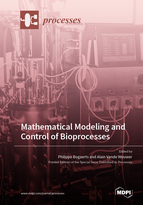Mathematical Modeling and Control of Bioprocesses
A special issue of Processes (ISSN 2227-9717). This special issue belongs to the section "Biological Processes and Systems".
Deadline for manuscript submissions: closed (30 November 2021) | Viewed by 36960
Special Issue Editors
Interests: mathematical modeling; parameter estimation; network analysis; model-based optimization; control and state estimation with application to biological systems and bioprocesses
Interests: mathematical modeling; metabolic flux analysis; numerical simulation; identification; data-driven techniques; process control; model predictive control
Special Issues, Collections and Topics in MDPI journals
Special Issue Information
Dear Colleagues,
This Special Issue on Mathematical Modeling and Control of Bioprocesses aims at presenting novel scientific contributions to mathematical modeling in major areas of biotechnologies, including biological cultures in biopharmaceutical or in agro-food industries, environmental bioprocesses, biomass valorization processes, etc. Contributions may focus either on the development of the mathematical model itself and/or the modeling procedure (new model structures, model identification), or on the use of mathematical models for bioprocess supervision, diagnosis, state observation, operation, optimization, and control. Mathematical models at macroscopic or at microscopic levels may be considered. In this latter category, the analysis of metabolic networks is a topic of particular interest.
Mathematical models or, in contrast, data-driven techniques can be the basis to determine desirable operating conditions and to design optimizing control strategies, which is the second set of topics of this Special Issue.
New methods (or method extensions) in mathematical modeling and control should be validated with experimental or simulated data.
Areas of interest include:
- Modeling and identification
- Parameter and state estimation
- Optimal experiment design
- Fault diagnosis and monitoring
- Model-based optimization and control
- Data-driven control
- Metabolic networks, metabolic flux analysis, flux variability analysis, elementary flux modes
with applications to
- Microbial (bacteria or yeast) cultures
- Mammalian and insect cell cultures
- Microalgae cultures
- Biopharmaceutical processes (vaccines, monoclonal antibodies production)
- Food engineering
- Environmental bioprocesses (waste water treatment, bioremediation)
- Biomass valorization processes (biohydrogen, biofuel, biopolymers production)
Prof. Dr. Philippe Bogaerts
Prof. Dr. Alain Vande Wouwer
Guest Editors
Manuscript Submission Information
Manuscripts should be submitted online at www.mdpi.com by registering and logging in to this website. Once you are registered, click here to go to the submission form. Manuscripts can be submitted until the deadline. All submissions that pass pre-check are peer-reviewed. Accepted papers will be published continuously in the journal (as soon as accepted) and will be listed together on the special issue website. Research articles, review articles as well as short communications are invited. For planned papers, a title and short abstract (about 100 words) can be sent to the Editorial Office for announcement on this website.
Submitted manuscripts should not have been published previously, nor be under consideration for publication elsewhere (except conference proceedings papers). All manuscripts are thoroughly refereed through a single-blind peer-review process. A guide for authors and other relevant information for submission of manuscripts is available on the Instructions for Authors page. Processes is an international peer-reviewed open access monthly journal published by MDPI.
Please visit the Instructions for Authors page before submitting a manuscript. The Article Processing Charge (APC) for publication in this open access journal is 2400 CHF (Swiss Francs). Submitted papers should be well formatted and use good English. Authors may use MDPI's English editing service prior to publication or during author revisions.
Keywords
- Bioprocesses
- Mathematical modeling
- Parameter estimation
- State estimation
- Model-based optimization
- Model-based control
- Data-driven control
- Metabolic network
- Metabolic Flux Analysis







